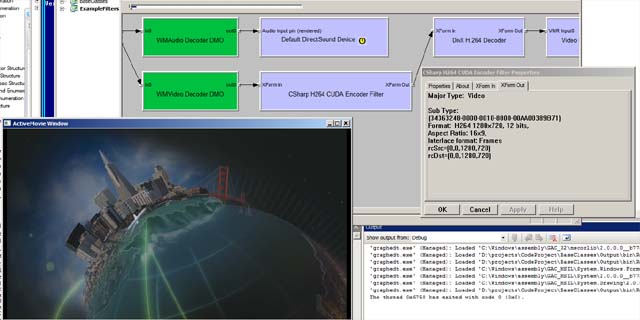
Up to 256 full-color overlay regions are supported on the composite output, and up to eight monochrome-only regions are supported on compressed and preview streams (except low latency preview). Overlay images and high quality, styled unicode text (bold, italic, underline, outline and shadow) can be displayed on top of the composite video output, compressed streams, or preview stream (but not low latency preview stream). Supported variables include time, date, and frame count. Text variables are automatically updated every video frame. A unique text string, consisting of mixed constant and variable text, may be defined for each overlay generator. The overlay generators can position up to 160 characters of text anywhere in the video frame. MP4 files can be edited in Adobe Premiere Pro with A/V sync preserved. Hardware-generated timestamps are employed to keep audio synchronized to the video, thus eliminating "lip sync" problems. The input can also be used to control the flow of any stream, without host involvement. The input is sampled every millisecond and, when a state change is detected, a notification is sent to the application program. The output is optically isolated, while the input may be either optically isolated or galvanically coupled. One general purpose digital input and one output are provided. The transport stream uses AAC audio and H.264 for MPEG-4. The 2253 supports transport streams by packaging elementary streams with error correction and stream synchronization to help maintain integrity when the signal is degraded. Video and audio are available as elementary streams or may be multiplexed in MP4 container format.

Up to 1024 bytes of application-supplied data can be inserted in the H.264 or MPEG stream at regular frame intervals or single shot, and closed captions are supported for H.264 streams.

Pause and resume are supported for both stream capture and playback.

Image transformations (resolution, rotation, mirroring) are independently configurable for each stream, as well as compression type and bit rate in the case of compressed streams. One of the streams can be a low-latency uncompressed stream (useful for real time previewing) and the other compressed, or both streams may be compressed. Multiple, independent video processors allow the unit to simultaneously produce two different video streams from its single composite input and send the streams out over USB. Its small size (1.5" x 2.75") and low power consumption (1.5 Watts) make it ideal for both portable and embedded applications. Model 2253 is a compact and robust USB-compatible audio/video codec that is powered from a single USB port.


 0 kommentar(er)
0 kommentar(er)
